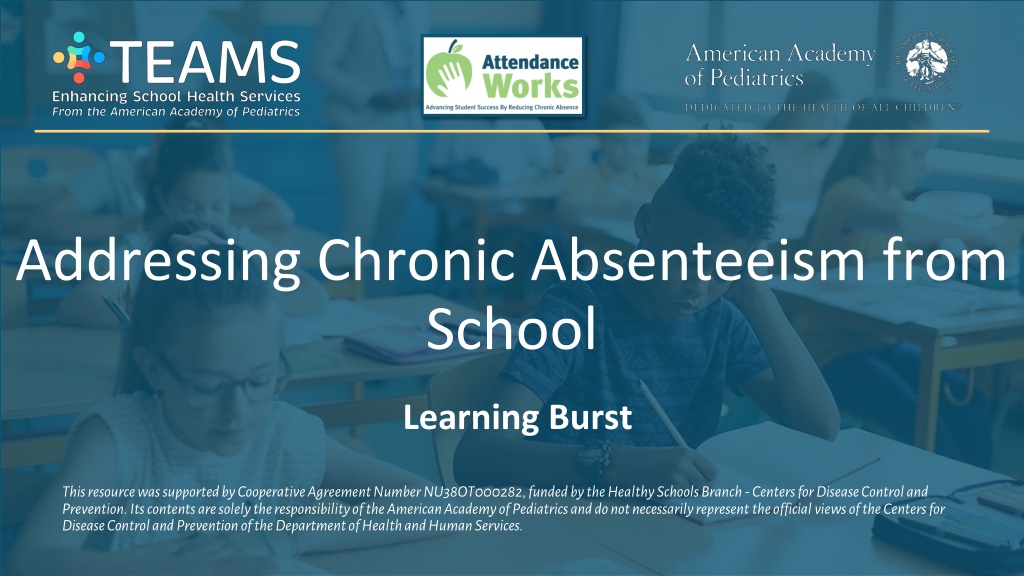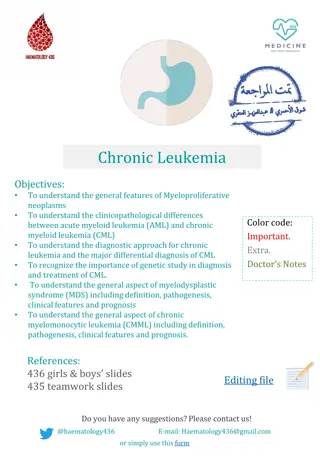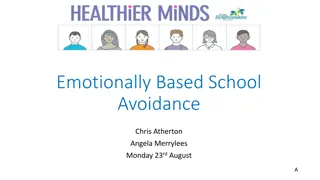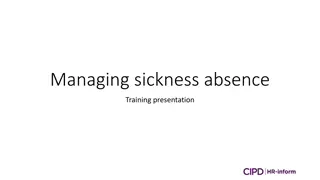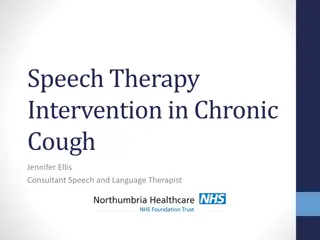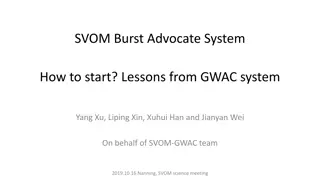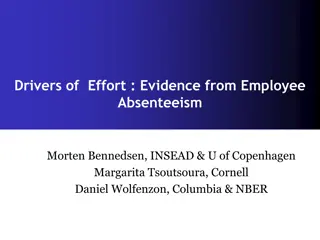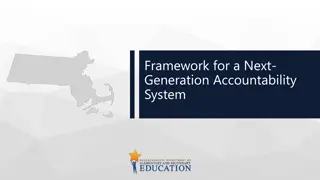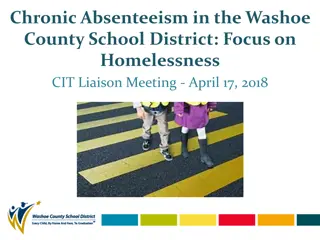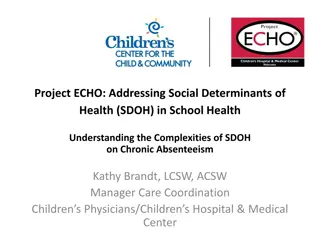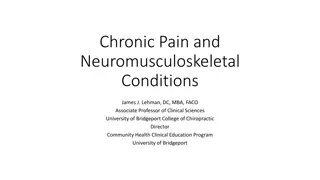Addressing Chronic Absenteeism in Schools: Learning Burst Summary
Chronic absenteeism in schools is a significant issue impacting students' academic success and overall well-being. This learning burst resource delves into understanding chronic absenteeism, its causes, and evidence-based interventions to improve attendance and reduce inequities. By collaborating with healthcare providers, schools can promote better attendance rates. The resource explores the implications of chronic absence, the attendance crisis faced by the United States, and the link between chronic absenteeism and health issues, emphasizing the importance of addressing this issue to ensure students' academic progress and long-term health outcomes.
- Chronic Absenteeism
- School Attendance
- Learning Interventions
- Health Implications
- Educational Inequities
Download Presentation

Please find below an Image/Link to download the presentation.
The content on the website is provided AS IS for your information and personal use only. It may not be sold, licensed, or shared on other websites without obtaining consent from the author. Download presentation by click this link. If you encounter any issues during the download, it is possible that the publisher has removed the file from their server.
E N D
Presentation Transcript
Addressing Chronic Absenteeism from School Learning Burst This resource was supported by Cooperative Agreement Number NU38OT000282, funded by the Healthy Schools Branch -Centers for Disease Control and Prevention. Its contents are solely the responsibility of the American Academy of Pediatrics and do not necessarily representthe official views of the Centers for Disease Control and Prevention of the Department of Health and Human Services. 1
Learning Outcomes By the end of this learning burst, participants will be able to: Understand chronic absenteeism and why it matters. Describe major causes of absenteeism including health-related factors. Identify evidence-based physical and mental health interventions that can improve attendance and reduce inequities. Discuss how schools and healthcare providers can collaborate to promote school attendance.
What is Chronic Absenteeism? Chronic Absence Measures Lost Opportunity to Learn Chronic absence is defined as missing 10% or more of school for any reason. Chronic Absence Excused absences Unexcused absences Suspensions Chronic absence is different from truancy (unexcused absences only) or average daily attendance (how many students show up to school each day).
The United States Faces an Attendance Crisis Pre-pandemic: 8 million (1 out of 6) students were chronically absent (missing 10% or more of school for any reason: excused, unexcused, suspension) Chronic absence is higher than ever, especially in early elementary and all throughout high school. By the end of school year (SY) 2021-22, data from multiple states showed chronic absence often doubled and affected more than 1 out of 4 students. Early district and state SY 2022-23 data show rates remain high. Economically disadvantaged students and families as well as Native American, Black, Latino/Hispanic, and Pacific Islander students are disproportionately affected. Using Chronic Absence to Map Interrupted Schooling, Instructional Loss and Educational Inequity Monitoring Data Matters Even More: A Review of State Attendance Data Policy and Practice in School Year 2022-23 State Policy Review Table 2023
The Link Between Chronic Absence and Health Chronic absence is a warning sign that a health-related condition or a social determinant of health may need to be addressed. Children with acute and chronic health conditions are more likely to be absent from school. Students who are chronically absent from school are more likely to display behavior and discipline problems and engage in unhealthy activities including smoking, drug use, and risky sexual behaviors. Chronic absence is an early warning sign that students are off track for reading by the end of third grade, completing middle school, and graduating from high school. Dropping out is associated with worse long-term health outcomes. The Importance of Being in School: A Report on Absenteeism in the Nation s Public Schools Present, Engaged, and Accounted For: The Critical Importance of Addressing Chronic Absence in the Early Grades Preschool Attendance in Chicago Public Schools: Relationships with Learning Outcomes and Reasons for Absences Chronic Absenteeism in Utah Public Schools Addressing the Health-Related Causes of Chronic Absenteeism: A Toolkit for Action Vital Signs for Pediatric Health: Chronic Absenteeism Associations of health risk behaviors with school absenteeism. Chronic Absenteeism Among Kindergarten Students
Reciprocal Causal Relationship Health Education Poverty Childhood and Intergenerational Poverty: The Long-Term Consequences of Growing Up Poor Healthier Students Are Better Learners: High-Quality, Strategically Planned, and Effectively Coordinated School Health Programs Must Be a Fundamental Mission of Schools to Help Close the Achievement Gap
Reducing Chronic Absence Requires Addressing Underlying Causes of Absenteeism Including Health Challenges and Social Determinants of Health Disengagements Aversion Misconceptions Barriers Chronic and acute illness Family responsibilities or home situation Trauma Poor transportation Housing and food insecurity Inequitable access to needed services (including health) System involvement Lack of predictable schedules for learning Lack of access to technology Community violence Struggling academically and/or behaviorally Unwelcoming school climate Social and peer challenges Anxiety Biased disciplinary and suspension practices Undiagnosed disability and/or lack of disability accommodations Caregivers had negative educational experiences Lack of challenging, culturally responsive instruction Bored No meaningful relationships to adults in the school (especially given staff shortages) Lack of enrichment opportunities Lack of academic and behavioral support Failure to earn credits Need to work conflicts with being in high school Absences are only a problem if they are unexcused Missing 2 days per month doesn t affect learning Lose track and underestimate TOTAL absences Assume students must stay home for any symptom of illness Attendance only matters in the older grades Suspensions don t count as absence Addressing the Health-Related Causes of Chronic Absenteeism: A Toolkit for Action Portraits of Change: Aligning School and Community Resources to Reduce Chronic Absence
Health-Related Barriers to Learning APA Children s mental health is in crisis 2022 Trends Report AAPD The State of Little Teeth Second Edition CDC Data and Statistics on Children s Mental Health CDC About Teen Pregnancy KFF The Landscape of School-Based Mental Health Services
Strong Attendance Requires Investing in Positive Conditions for Learning This image is credited to Using Chronic Absence Data to Improve Conditions for Learning developed by Attendance Works and the American Institutes for Research.
Improving Attendance Requires A Multi-tiered System of Support Tier 3 Intensive Intervention Intervention Tier 3 Intensive Students Missing 20% or More Tier 2 Students Missing 10% - 19% Early Intervention All Students and Families Tier 1 Universal Prevention Foundational Supports All Students and Families Which Promote Positive Conditions for Learning Chronic Absence 3 Tiers of Intervention Attendance Playbook: Smart Solutions for Reducing Student Absenteeism Post-Pandemic
Tier 1 Universal Prevention Examples: Work with main office to ensure staff are being informed of sick related absences. Help educate families about the importance and benefits of regular school attendance. Help families identify and address barriers to attendance, especially those related to access to health care. Provide firm guidance on when a child should stay home if sick and how to avoid absences from minor illness or anxiety. Work with school and district to raise awareness around appropriate and inappropriate reasons for exclusion. Attendance Works Chronic Absence 3 Tiers of Intervention
Tier 2 Early Intervention Examples: Prevent, identify, and treat physical and mental health conditions that are contributing to school absences. Ensure that children with chronic health issues, such as asthma, allergies, and seizures, work with a school nurse and have an action plan at school so students feel confident in the classroom and the family feels secure sending their child to school. Contact community health providers about offering extended office hours and encourage families to make preventive care appointments and follow-up appointments for times outside of regular school hours. Work with the caregivers of students with excessive absences to schedule a school team meeting to discuss how the school, student, and family can collaborate to address the issue. Attendance Works Chronic Absence 3 Tiers of Intervention
Tier 3 Intensive Intervention Examples: Educate the school or school district on the importance of using school health staff (school nurses, social workers, school-based health centers, etc.) to provide services such as intensive case management and mentorship. Communicate and collaborate with other health professionals about providing support services in school(s). Serve as a student health advocate and ensure students are connected to appropriate medical experts. Encourage eligible families to utilize home or hospital educational services from the public schools if they have a legitimate medical reason for absences. Attendance Works Chronic Absence 3 Tiers of Intervention
Evidence-Based Health Interventions Across Multiple Tiers That Improve School Attendance School Policies Improving school climate and student connectedness can lead to improved attendance and a decrease in risky behaviors. A Whole School, Whole Community, Whole Child approach can help promote student health and improve academic performance. Infection Prevention and Screenings Support hygiene practices, school-based vaccination programs, and more. Implement screenings for vision, dental, behavioral health, chronic health issues, food/housing insecurity, etc. School Nurses Have one full time nurse in every school! 95% of students who see a school nurse are able to return to class. School-Based Health Centers There is a 25% decrease in tardiness and 50% decrease in absenteeism for HS students who received school-based mental health services. Mental Health Services A trauma informed approach in schools can help decrease suspensions and improve attendance and school performance. The Link Between School Attendance and Good Health
A Strong School Infrastructure Is Key! Improve collection of school health data. Ensure that need-to-know individuals have access to student health information, including attendance data, through a health information network. Develop accountability measures around school climate, air quality, health programs, and policies. Use technology (telemedicine) to overcome challenges around health care access.
Recap Reducing chronic absenteeism is essential to improving educational and health outcomes. Improving attendance requires identifying and addressing health related barriers and adoption of a tiered approach that begins with prevention. School health staff and other health care providers should work together to monitor chronic absenteeism and take collective action to improve attendance and reduce inequity.
Make discussions about attendance a priority. Connect with school and district leadership. Establish and expand partnerships to address health related barriers.
Resources American Academy of Pediatric Dentistry: The State of Little Teeth Second Edition American Academy of Pediatrics: School-Based Health Centers and Pediatric Practice American Academy of Pediatrics: Role of the School Nurse in Providing School Health Services American Academy of Pediatrics: The Link Between School Attendance and Good Health American Psychological Association: 2022 Trends Report - Children s mental health is in crisis Attendance Works: Chronic Absence 3 Tiers of Intervention Attendance Works: Monitoring Data Matters Even More: A Review of State Attendance Data Policy and Practice in School Year 2022-23 Attendance Works: Portraits of Change: Aligning School and Community Resources to Reduce Chronic Absence Attendance Works: State Policy Review Table 2023 Attendance Works: Using Chronic Absence Data to Improve Conditions for Learning Attendance Works: Using Chronic Absence to Map Interrupted Schooling, Instructional Loss and Educational Inequity
Resources Attendance Works & Healthy Schools Campaign: Mapping the Early Attendance Gap: Charting a Course for Student Success Center for Disease and Control: About Teen Pregnancy Center for Disease and Control: Data and Statistics on Children s Mental Health FutureEd: Attendance Playbook: Smart Solutions for Reducing Student Absenteeism Post-Pandemic Johns Hopkins University: The Importance of Being in School: A Report on Absenteeism in the Nation s Public Schools KFF: The Landscape of School-Based Mental Health Services Healthy Schools Campaign: Addressing the Health-Related Causes of Chronic Absenteeism: A Toolkit for Action Journal of School Health: Associations of health risk behaviors with school absenteeism. Does having permission for the absence make a difference?
Resources Journal of School Health: Healthier Students Are Better Learners: High-Quality, Strategically Planned, and Effectively Coordinated School Health Programs Must Be a Fundamental Mission of Schools to Help Close the Achievement Gap National Academy of Medicine: Vital Signs for Pediatric Health: Chronic Absenteeism National Center for Children in Poverty: The Critical Importance of Addressing Chronic Absence in the Early Grades National Center for Children in Poverty: Childhood and Intergenerational Poverty: The Long- Term Consequences of Growing Up Poor UChicago Consortium on School Research: Preschool Attendance in Chicago Public Schools University of Rhode Island Data HUB: Chronic Absenteeism Among Kindergarten Students University of Utah: Chronic Absenteeism in Utah Public Schools 21
22 Additional Questions Contact Agency Contact Person and Title Contact Email Address Contact Phone Number
